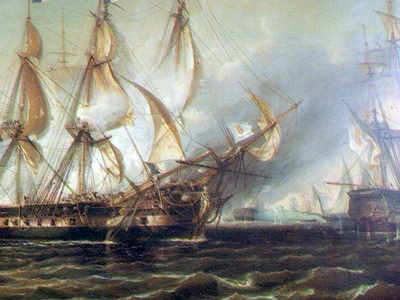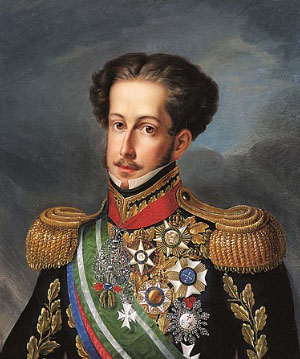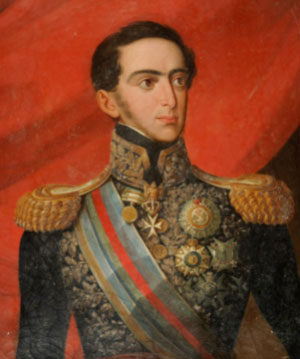Portuguese Civil War (1828-1834)
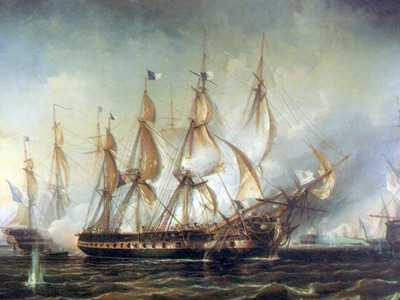
Battle of the Tagus (1831)
The Battle of the Tagus was a naval engagement that took place on 11 July 1831 at the mouth of the Tagus river, in Portugal. A French fleet attacked and subdued Portuguese fortifications at the entrance of the Tagus, with the aim to strong-arm the government of Miguel I into recognising the newly established Kingdom of the French The July Monarchy, officially the Kingdom of France, was a liberal constitutional monarchy in France under Louis Philippe I, starting on 26 July 1830, with the July Revolution of 1830, and ending 23 February 1848, with the Revolution of 1848. It marks the end of the Bourbon Restoration (1814–1830). It began with the overthrow of the conservative government of Charles X, the last king of the House of Bourbon.. The damage to the forts defending access to the Tagus and the arrival of French warships at Lisbon forced the Portuguese to cave in and comply with French demands.
The July Monarchy, officially the Kingdom of France, was a liberal constitutional monarchy in France under Louis Philippe I, starting on 26 July 1830, with the July Revolution of 1830, and ending 23 February 1848, with the Revolution of 1848. It marks the end of the Bourbon Restoration (1814–1830). It began with the overthrow of the conservative government of Charles X, the last king of the House of Bourbon.. The damage to the forts defending access to the Tagus and the arrival of French warships at Lisbon forced the Portuguese to cave in and comply with French demands.
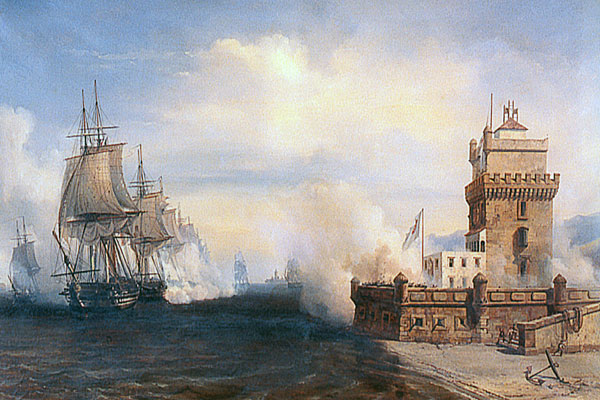
The flagship Suffren, leading French line of battle, exchanges broadsides with Belém Tower moments before breaking into Lisbon
Background
The accession of King Miguel I to the throne of Portugal and abolition of the Constitutional Charter had put the country under the rule of an absolutist monarch. Liberals challenged this usurpation, and the struggle of the Liberal Wars ensued. The government of Miguel I was hostile to France, and became even more so when the popular insurrection of the July Revolution deposited the absolutist Bourbon king Charles X, and established a constitutional monarchy in which Louis-Philippe had become "King of the French". Miguel Refused to recognise the Monarchy of July, while neither the French nor the British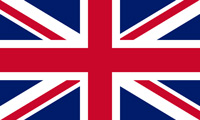 The United Kingdom of Great Britain and Ireland was a sovereign state in Northwestern Europe that comprised the entirety of the British Isles between 1801 and 1922. The United Kingdom, having financed the European coalition that defeated France during the Napoleonic Wars, developed a large Royal Navy that enabled the British Empire to become the foremost world power for the next century. government recognised his.
The United Kingdom of Great Britain and Ireland was a sovereign state in Northwestern Europe that comprised the entirety of the British Isles between 1801 and 1922. The United Kingdom, having financed the European coalition that defeated France during the Napoleonic Wars, developed a large Royal Navy that enabled the British Empire to become the foremost world power for the next century. government recognised his.
In early 1831, a French citizen, Edmond Potentin Bonhomme was sentenced to public flogging, a fine and exile for allegedly profaning a church, a claim that French officials dismissed as "they had good reason to believe that many of the statements it comprehends, have no other foundation than the bigotry and malevolence of the Portuguese priesthood". Several other French citizen were similarly detained in what the French government judged to be arbitrary manners.
The French consul in Lisbon, Cassas, was tasked to present a diplomatic demarche to the Portuguese government, but he was rebuffed as not having the diplomatic credentials of an ambassador. Viscount d'Asseca requested a mediation of the British Foreign minister, Viscount Palmerston, who advised the Portuguese to comply with French demands. A squadron under Captain de Rabaudy, comprising the 60-gun frigate Melpomène and the 18-gun brig Endymion, under Nonay, was sent to the mouth of the Tagus river to show the flag and give weight to the demands of the French consul. They arrived on 16 March 1831. Upon her departure from Brest, Melpomère ran aground on Basse Beuzec, and had to double back, leaving Endymion to continue her route. When Melpomère finally arrived on 16 May 1831, Endymion was already returning to France, with the consul aboard. Rabaudy Stated the purpose of his mission to Portuguese authorities and delivered the French ultimatum, demanding:
- the release of the two imprisoned Frenchmen and the annulation of their sentence
- an indemnity in their favour
- destitution of the judges responsible
- indemnities for a number of other Frenchmen
- that Frenchmen be only arrested with the consent of a French judge, as was their privilege at the time.
These demands had to be met 48 hours after reception.
Portuguese authorities played for time. In consequence, Rabaudy's Melpomène started blockading Lisbon by preying upon shipping leaving and entering the Tagus, though their crew were immediately freed and sent ashore. Melpomère was soon reinforced by a squadron under Captain Charmasson, of the 52-gun Sirène, escorted by the 18-gun corvettes Diligente and Églé, and the 20-gun brig Hussard. While some of the ships cruised off the mouth of the Tagus, the others were detached to Azores to hunt for a Portuguese Miguelist division that blockaded the Liberal controlled Terceira Island; on 3 June, these ships captured the 24-gun corvette Urania and the 6-gun fluyt Oreste, but they failed to locate the rest of the Miguelist forces, and thus returned to the mouth of Tagus.
In spite of the French blockade and their undermining of its war effort against Liberals, the Portuguese government refused to meet French demands, and the treatment of the French prisoners even deteriorated. The French therefore decided to escalate the matter, and Henri de Rigny, French Minister of the Navy, appointed rear-Admiral Baron Albin Roussin to a 6-sail of the line squadron. Roussin was a veteran of the Mauritius campaign of 1809–1811, and had been honoured for his conduct at the Battle of Grand Port.
The mission of Rear-admiral Roussin was to sail to Tagus, with his flag on the 90-gun Suffren, and give the Portuguese authorities an ultimatum that demanded, in addition to that already given by Rabaudy, that the chief of the Portuguese police be dismissed; that all court sentences against French citizens be annulled; and that indemnities be paid to compensate for the costs induced by the expedition. The ultimatum expired 48 hours from reception, at which point the French forces would force the entrance of the Tagus, sail to Lisbon and bombard the city. Departed from Brest, the squadron arrived off the Tagus on 25 June, and stayed there waiting for the division inbound from Toulon, under Read-admiral Hugon.
On 31, the Portuguese government mobilised the warship on the Tage, though only two frigates and smaller warships could be marshaled at once; the strongest asset on Tage, the 74-gun Dom João VI, needed over a month of work worth of repairs, and the 52-gun frigate Amazona could not be readied before twenty days. This left only the 54-gun Diana and the 44-gun Pérola, with the 26-gun Dom João I and Lealdade, to oppose the much stronger French squadron. In addition, all the ships that the Portuguese could muster were much under-handed. The condition deteriorated on 1 July when Suffren and Melpomène chased the Lord Wellington, a Portuguese merchantman inbound from Bahia; Lord Wellington fled under Fort Santo António to benefit from its protection. When the French ship approached, the fort opened fire, and a gunnery exchange broke out while the ships' boats were launched and captured the merchantman. The French bombardment silenced the fort, killing five or six soldiers, and severely wounding thirty.
On 6, Hugon's squadron arrived from Toulon. Being forced to inaction by unfavourable winds, Roussin attempted a last diplomatic demarche and on 10, he sent the 18-gun brig Dragon, under Commander Théodore Deloffre, to present a last ultimatum; Dragon also carried letters for the ships of the Tagus and for foreign diplomatic missions in Lisbon, and was under strict orders not to remain at anchor more than 24 hours. The new ultimatum comprised the same condition as the first, but added that the Portuguese government should compensate France for the price of the naval expedition, and threatened of a "de facto war". Dragon returned to the French fleet the next day with a refusal, though Santarem attempted to surrender his French prisoners to the British as a token concession. Captain Vincent Moulac, of Algésiras, advised that the fleet attempt to force the entrance of the river and sail upstream to Lisbon.
On 11, the winds had turned, and a North-North-West wind allowed for the expedition upstream. The French squadron manoeuvred to form a line of battle, and at 13:30, it sailed into the Southern pass. The French squadron sailed one by one in front of the forts, delivering broadsides at distances varying from 100 to 1000 metres, and reached Paço de Arcos in good order and with no serious damage. Roussin signaled his ships to sail on, but the two lead ships, Marengo and Algésiras, failed to spot the signals and dropped their anchor, as was initially planned to repair damage sustained during the forcing of the pass; seeing that the flagship Suffren sailed before them without stopping, they promptly put to sail and took a place in the French line, but this mistake put Suffren at the front of the line.
Around 16:00, Suffren opened fire on the Belém Tower at a distance of 100 metres, soon followed by the rest of the squadron, and anchored in front of the Belém Palace while the other ships and frigates sailed on to the anchored Portuguese fleet. When the lead ship, Pallas, opened fire on the Portuguese squadron, all its ships struck, without firing a shot.
By 17:00, the entire French squadron was anchored before the docks of Lisbon, and Roussin sent his chief of staff, Lieutenant commander Charles Ollivier, to present the French ultimatum once again with a 2-hour delay. The Portuguese government attempted once again to turn its prisoners over to British officials, but the offer was once again refused. The Portuguese government caved in, and a treaty was signed on 14 July on Suffren by Castello Branco and Roussin, with its dispositions published in the Lisbon Gazette on 15, and the sums of money begin paid in cash by the 23. With the ultimatum accepted by the Portuguese, Roussin sent most of the squadron to sea, staying in front of Lisbon with only Suffren, Pallas and Melpomène; the 58-gun frigate Guerrière, under Captain Kerdrain, rejoined him on 29.
Aftermath
The treaty of 14 July specified that the French would return the ships captured before the attack on the Tagus, including the warships Orestes and Urania and the merchantmen with their cargo. After a council of war on Trident, the French decided to also return the captured 74-gun Dom João VI as, being neither armed nor manned during the action, she did not belong to an opposing force.
Nothing was said, however, of the fleet captured at Lisbon itself. The Portuguese government protested, and Roussin proposed that the ships be re-purchased for 1.5 million cruzados, or to return half the captured ships, in exchange for the release of 400 political prisoners. When this offer was rejected, the ships in question were incorporated in the French fleet.
The French squadron of Toulon departed on 25; the prizes Diana, Amazone, Don João I and Don Pedro departed with on 12 with a brig, and the next day Perola, Lealdade, Saint Sebastian and Memoria followed. The rest of the fleet eventually departed for Brest on 14 August, where it arrived on 4 September, leaving only Melpomène and Églé.
In recognition for the deed, Roussin was promoted to Vice-admiral.
The Miguelists would suffer a crushing defeat at the hands of the Liberals at the Battle of Cape St. Vincent two years later, ending the usurpation of Miguel I.
HISTORY

RESOURCES
This article uses material from the Wikipedia articles "Liberal Wars" and "Battle of the Tagus", which is released under the Creative Commons Attribution-Share-Alike License 3.0.
© Stories Preschool. All Rights Reserved.
